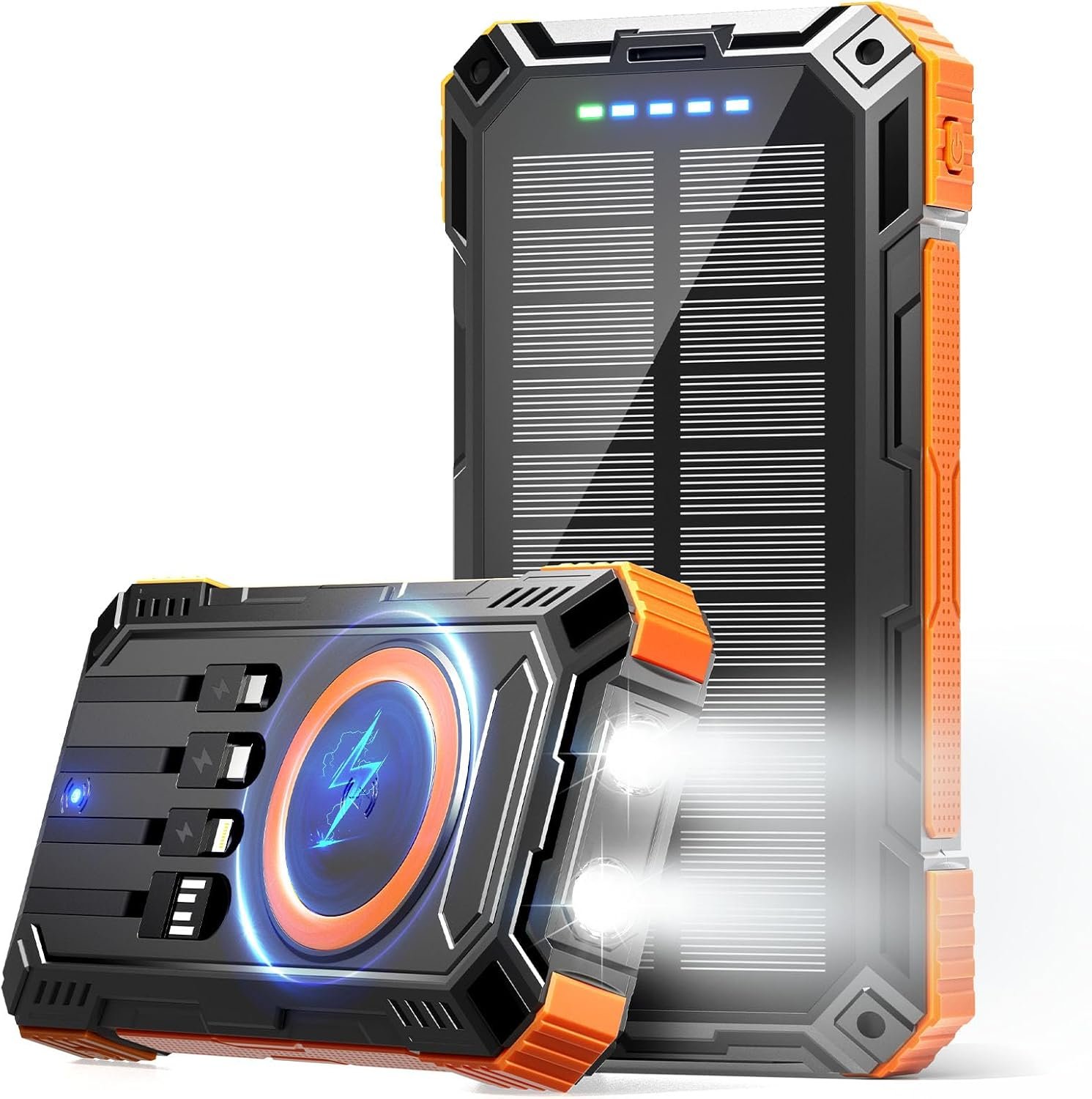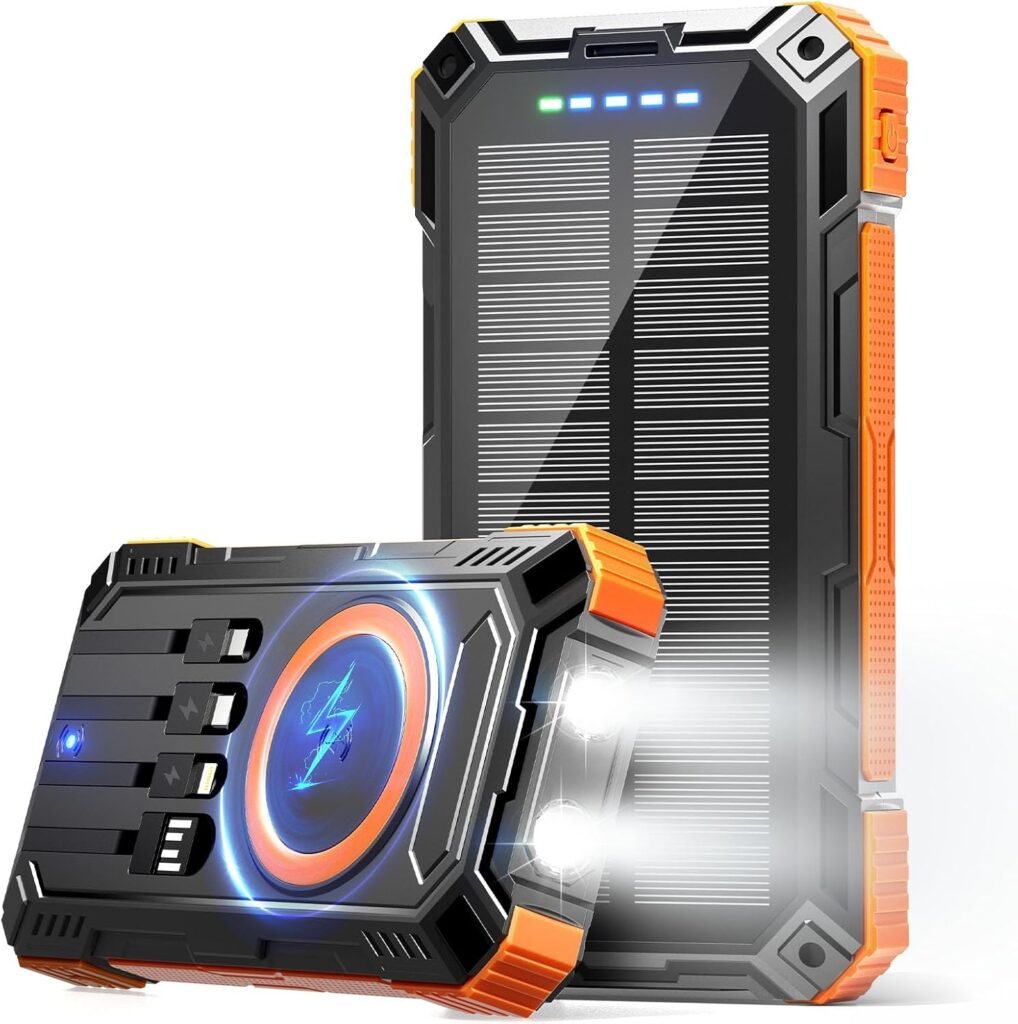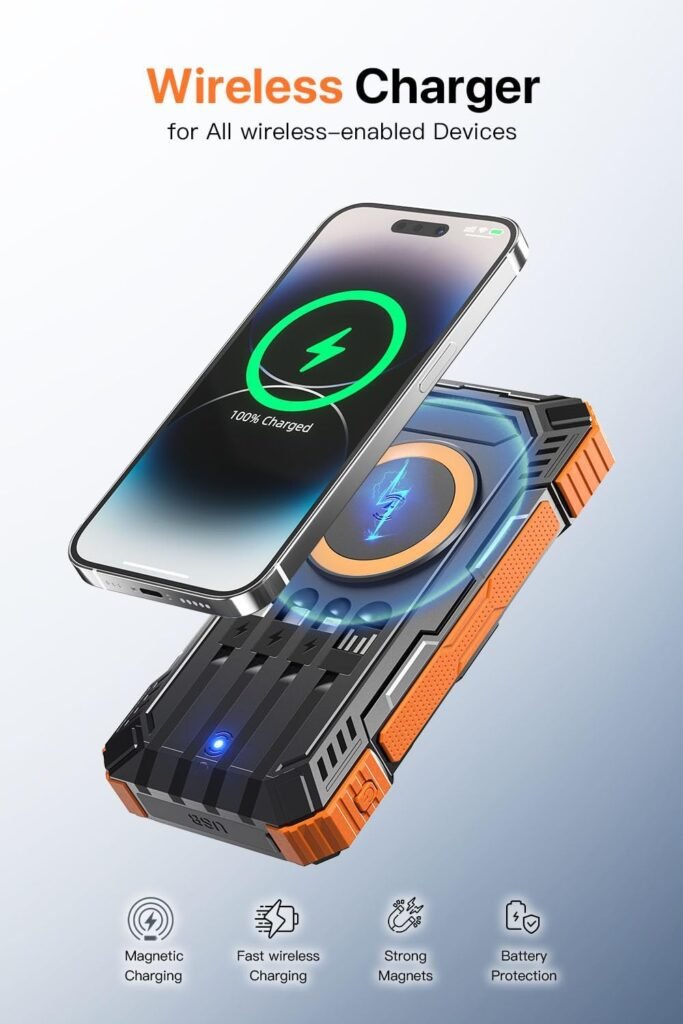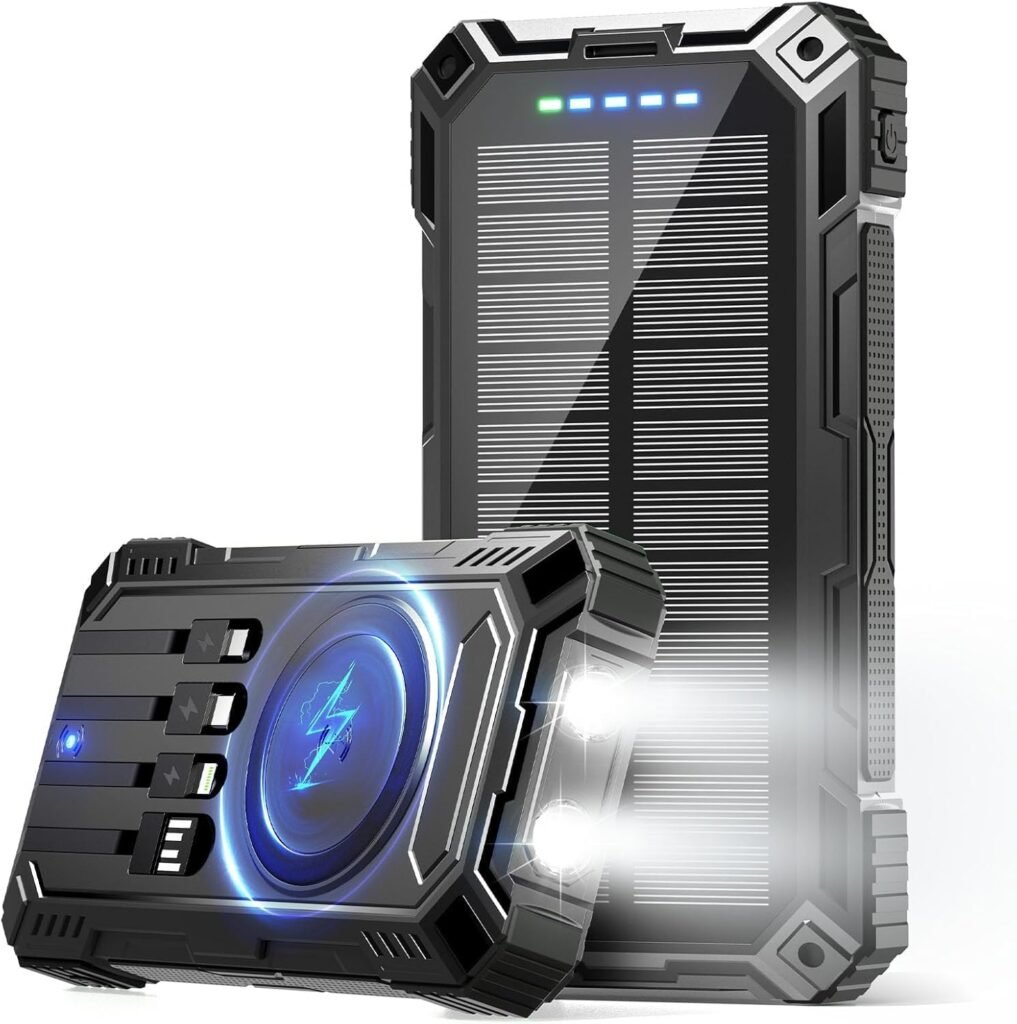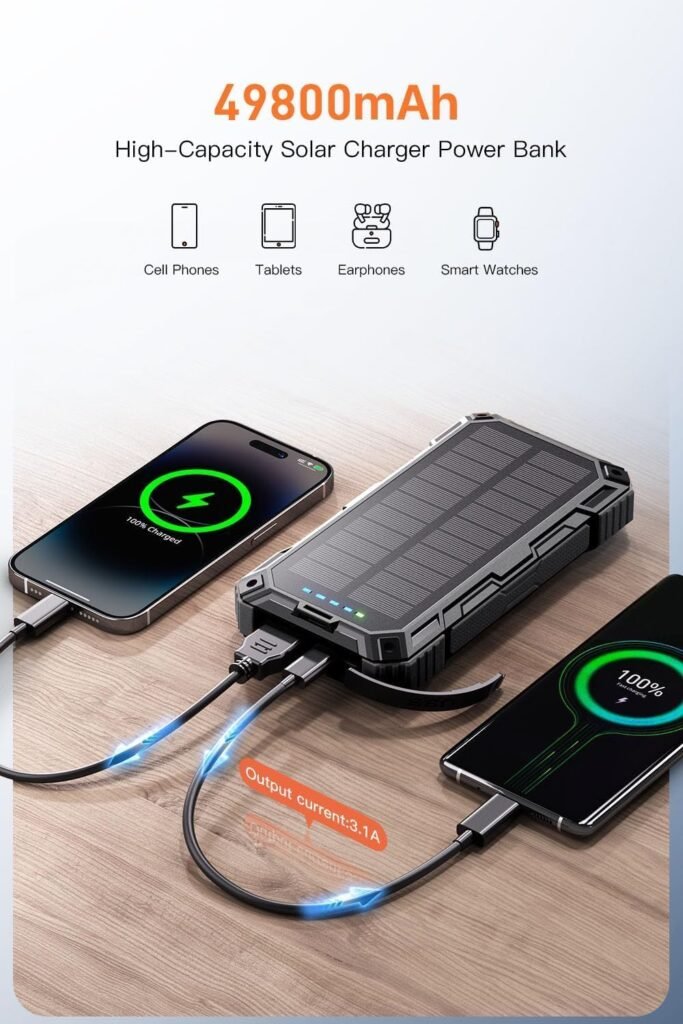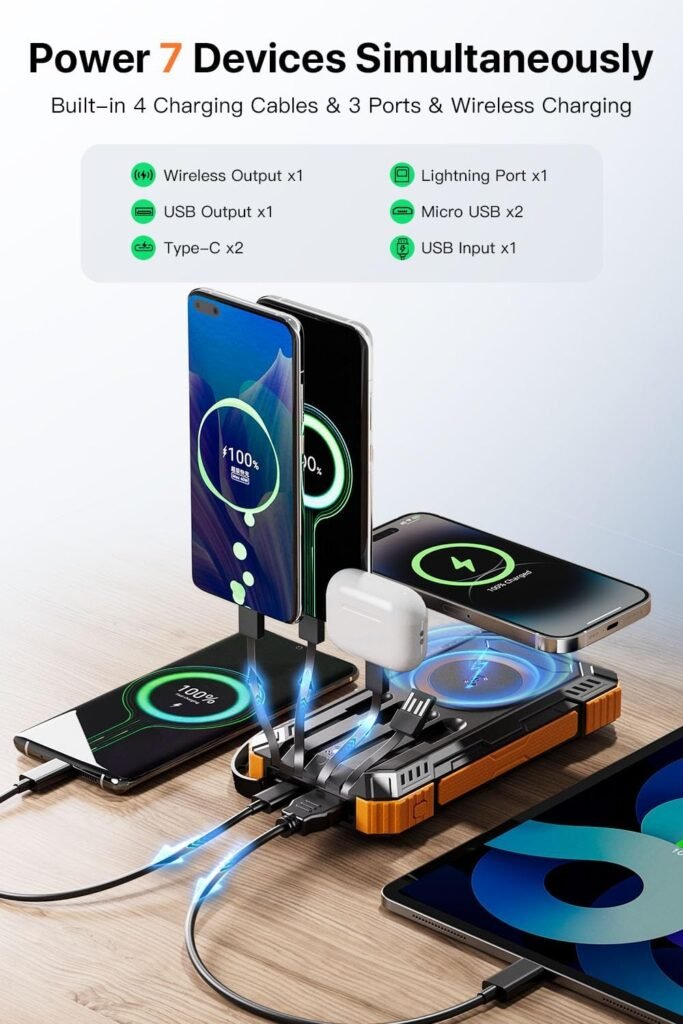Solar Power Bank 49800mAh Wireless Portable Charger Review
Solar Power Bank 49800mAh Wireless Portable Charger Review
Looking for a rugged, high-capacity power solution that keeps your devices alive through long trips and emergencies?
First impression
You get the sense right away that this Solar Power Bank 49800mAh Wireless Portable Charger with USB-C 15W Fast Charging with 4 Built-in Cables LED Flashlight Battery Pack Compatible with iPhone, iPad, Galaxy, Perfect for Camping, Hiking was designed to be a workhorse. From its chunky, impact-resistant shell to the integrated cables and LEDs, it feels made for real-world use rather than just a tech shelf piece. You’ll notice the practical choices—built-in cables, wireless charging, and a bright flashlight—designed to reduce the number of things you need to carry.
Key specifications
This table breaks down the headline specs so you can scan core details quickly and compare features at a glance.
| Feature | Specification / Notes |
|---|---|
| Brand | JSKEI (trusted solar power pioneer for 10+ years) |
| Battery Capacity | 49,800 mAh (lithium-polymer) |
| Charge Cycles | 1,500+ cycles (manufacturer claim) |
| Fast Charge | USB-C 15W (0% → 50% in ~30 minutes claim for compatible phones) |
| Outputs | 2 x USB-A ports + USB-C output + wireless charging + 4 built-in cables |
| Built-in Cables | USB-A input, USB-C, Micro-USB, Lightning |
| Simultaneous Charging | Up to 6 devices at once (built-in + ports + wireless) |
| Materials | Flame-retardant ABS + PC |
| Ruggedness | IP65 (waterproof, dustproof, shockproof) |
| Flashlight | Dual ultra-bright LED with SOS mode |
| Safety | Smart safety chip (overcharge, over-discharge, overheating, short circuit) |
| Solar Charging | Onboard solar capability (useful as trickle/backup) |
| Ideal Uses | Camping, hiking, road trips, emergencies, blackouts |
| Missing / Not Specified | Exact weight, physical dimensions, solar panel wattage, precise wireless wattage |
You’ll notice some specifics like solar wattage and weight aren’t published in the details you were given, so if those are important to you it’s worth checking the product page or asking the seller before buying. The core performance figures—capacity, durability, and charging flexibility—are all very well highlighted by JSKEI.
Capacity and what it means for you
A 49,800 mAh rating sounds enormous and it is; practically it means you can recharge multiple devices many times. The manufacturer claims you can charge an iPhone 16 up to 8 times, a Samsung Galaxy up to 5 times, or an iPad up to 3 times. That’s enough power to keep you running for days on a trip or through a prolonged outage. You’ll appreciate not having to ration power or fight over outlets when several people need a boost.
Charging ports, built-in cables, and convenience
You don’t have to pack extra cables because this unit includes four integrated cables: a USB-A input, USB-C, Micro-USB, and Lightning. There are also two USB output ports and a USB-C port. Combine those with wireless charging and you can power up to six devices simultaneously. For group trips or families, that means everyone can recharge without hunting down adapters or swapping cables mid-hike.
Fast charging and wireless charging
The USB-C 15W fast charge is the headline: the product claims a compatible phone can jump from 0% to about 50% in 30 minutes. That speed is handy when you need a quick boost before heading out. Wireless charging is supported as well, providing cable-free convenience for Qi-compatible devices. Keep in mind that wireless is usually slower than wired fast-charging, and the actual speed depends on the phone model and whether multiple ports are used simultaneously.
Durability and build quality
This power bank is built from flame-retardant ABS and polycarbonate, materials that balance durability and weight. With an IP65 rating, it’s designed to resist water spray, dust ingress, and shocks—traits you want for outdoor gear. You’ll feel confident tossing it in a backpack or leaving it on a campsite table during light rain. It’s not invulnerable to submersion, so treat IP65 as strong protection for rough conditions rather than proof it can be dropped in a river.
Safety and battery health
Safety is taken seriously here: an advanced lithium-polymer battery is advertised as leak-free and long-lasting with 1,500+ cycles. A smart safety chip guards against overcharge, over-discharge, overheating, and short circuits. Those protections mean you can leave devices connected overnight or stow the bank in a vehicle without constant monitoring. You should still follow common-sense battery care—avoid extreme temperatures and physical damage.
Power and light: emergency usefulness
This isn’t just a battery pack; it’s also a lighting tool. Dual ultra-bright LED flashlights with an SOS mode can illuminate a campsite or help you signal during an emergency. You’ll find the integrated lights practical for finding gear in the dark or during power outages at home. The combination of large battery capacity and a built-in torch makes this device an appealing emergency kit piece.
Performance expectations and real-world behavior
You should treat the advertised numbers as what to expect under good conditions, not guaranteed outcomes in every situation. The 15W USB-C fast charge claim is plausible for many phones, and the big capacity is enough to repeatedly charge typical smartphones and tablets. That said, real-world factors like cable length, device compatibility, concurrent outputs, and temperature will influence speeds and effective cycles.
How charging multiple devices affects speed
When you charge several devices at once, the total output is shared, so individual device speeds will drop. If you’re trying to charge a phone quickly, use the USB-C port alone and avoid wireless or other USB outlets at the same time. For top speed on a single device, plug it into the USB-C port with the bank as the primary power source.
Solar charging: what you can realistically expect
The product carries the “Solar Power Bank” label and includes a solar panel for emergency or trickle charging. Don’t expect this onboard solar to match wall-socket speeds; it’s mainly for topping up when you have no other option. In strong sunlight it may extend runtime or slowly restore a partially depleted bank, but plan on using AC or vehicle charging to recharge fully in normal scenarios.
Setup and first use
When you first receive the charger, charge it fully via a wall outlet or a high-power USB charger. A fresh unit may come partially charged; a full initial charge helps calibrate the battery and ensures you’ll have the full advertised capacity when you need it. You can use the built-in USB-C input if available for faster recharges—just be mindful of the input amperage to avoid exceeding recommended limits.
Activation and firmware status
Most power banks require no software activation: they’re plug-and-play. Check the LED indicators to confirm charge level and test the built-in flashlight and SOS mode so you know how to toggle it under stress. If there are quirks like a specific button press sequence to enable wireless charging, take a minute to try that at home before you head out.
Charging times and what affects them
Exact recharge times depend on the input power you use. Charging from a high-wattage USB-C PD wall adapter will be much faster than using the solar panel or a low-power USB-A input. Expect several hours to recharge the full 49,800 mAh from a typical wall charger—this is a very large bank—so plan accordingly and don’t expect overnight recharges if you’re limited to low-power inputs.
Use cases and scenarios where it shines
This unit was built for people who spend time off-grid or frequently face power uncertainty. Here are a few typical situations where this charger is especially useful for you.
Camping and weekend trips
You can power phones, headlamps, cameras, and speakers across multi-day trips. The integrated cables mean you don’t have to pack as many extras, and the flashlight can replace a handheld torch in a pinch. The rugged build helps it survive being tossed into a wet, dusty car trunk or backpack.
Hiking and multi-day backpacking
If you’re on multi-day hikes and need a reliable backup, the capacity ensures device continuity. Take care with the weight and bulk—this is a large-capacity charger, so if weight is critical you may choose a lighter unit; if power and versatility are more important, it’s a great match.
Road trips and group travel
You can keep several people’s devices powered during long drives without hunting for adapters. The simultaneous charging capability means passengers can plug in and stay entertained, connected, or navigation-ready. It’s also handy to keep in the car as a backup for unexpected stops or long waits.
Emergency prep and home backup
During blackouts, this bank can keep essential phones and tablets working for days. The built-in flashlight and SOS mode add utility for emergency preparedness kits. You’ll want to store it charged and accessible—consider rotating its charge every few months to preserve battery health.
Everyday carry for heavy device users
If you often work remotely or rely on devices heavily during the day, this bank offers long endurance. The multiple ports let you charge a phone, tablet, and accessories simultaneously without searching for spare cables.
Maintenance and daily care
Treating this unit well will extend its life and keep it reliable. Keep it clean and dry when possible, avoid submersion, and don’t expose it to very high or low temperatures for prolonged periods. If you store it for a long time, hold its charge around 40–60% rather than fully charged or empty to reduce stress on the lithium-polymer cells.
Cleaning and inspection
Wipe the exterior with a damp cloth if dirty, and inspect built-in cables and ports for fraying or debris. The integrated cable junctions are often stress points, so don’t fold them sharply or yank them when unplugging devices.
Storage and long-term care
For long-term storage, power banks last longer when kept at partial charge in a cool, dry place. Charge it every few months to maintain cell health. Avoid leaving it discharged for months on end, which can lead to deep discharge and permanent capacity loss.
Pros and cons
Lay out the strengths and weaknesses clearly so you can decide if it matches your priorities.
Pros
- Massive 49,800 mAh capacity is ideal for extended trips or emergencies. You’ll rarely worry about running out of power.
- Four built-in cables remove the need to carry multiple cords, which is convenient for on-the-go charging. That reduces clutter in backpacks and bags.
- USB-C 15W fast charging offers quick top-ups for compatible phones when you need them most. It’s especially useful for short stops.
- Rugged build with IP65 rating gives confidence in wet, dusty, or rough conditions. It’s designed for outdoor use.
- Dual LED flashlight with SOS adds emergency readiness beyond simple power delivery. That can be invaluable at night or during outages.
- Smart safety chip and long cycle life (1,500+ cycles) signal a design focused on longevity and protection.
Cons
- The unit is large and likely heavy; it’s not as pocketable as smaller power banks. You’ll want it for specific trips or for a car kit, not daily pocket carry.
- Solar charging is useful but slow; rely on it only as a last resort or for slow topping-up. Don’t expect full recharges with the onboard panel in reasonable time frames.
- Exact weight, dimensions, and solar wattage aren’t listed in the provided details, so if size or panel performance matters you’ll need to check before purchase. That information may be available on the retail listing.
- Wireless charging speeds are typically slower than wired 15W USB-C; if speed is the priority, direct wired connection is better.
Who this is best for
You should consider this product if you:
- Spend multiple days away from reliable power and want a single solution to charge phones, tablets, and accessories. It reduces the need to carry multiple smaller banks.
- Lead group outings or travel with companions who all need power at once. The multi-device capability is a major advantage.
- Want an emergency power unit that doubles as a light source and can handle rough outdoor conditions.
- Prefer integrated cables to minimize extra gear and avoid forgetting cords in the field.
You might look elsewhere if:
- You need something ultra-lightweight for fastpacking or weight-critical hikes. This is a powerful but bulky solution.
- You require certified solar performance specs for long-term off-grid living with solar as a primary input.
Comparisons and alternatives
When you compare this JSKEI unit to other high-capacity power banks, several factors stand out: integrated cables, flashlight/SOS, IP65 rating, and a very large capacity. Competing models may offer higher USB-C PD wattage (like 30W–100W), integrated AC outlets, or specific solar wattage claims. If you need laptop charging at full speed or to run AC appliances, consider a portable power station with AC output instead of a large USB-focused power bank.
How it stacks up to a portable solar panel + separate power bank
A separate large solar panel plus compact power bank gives flexibility: you can position the panel for best sun while keeping a lighter power bank. JSKEI’s integrated solar option trades peak power for convenience. If you prioritize convenience and rugged integration, the JSKEI unit is compelling; if you prioritize recharging speed via solar when you’re off-grid for extended periods, a dedicated solar panel is likely better.
Buying advice and checklist
Before you buy, check these points to ensure the product meets your needs:
- Confirm weight and dimensions if you’re concerned about pack space or carrying comfort.
- Check the listed wireless charging wattage if speed is important for your devices.
- If solar recharging matters, ask the seller or look at the product manual for the solar panel’s wattage and expected charging times.
- Verify the included cables’ lengths and flexibility—short, stiff integrated cables can be inconvenient in some setups.
- If you plan to charge laptops or power-hungry tablets, confirm the USB-C port’s power delivery profile and maximum output.
Final verdict
If you want a rugged, feature-rich, very high-capacity power bank that reduces cable clutter and offers useful emergency lighting, this JSKEI Solar Power Bank 49800mAh model is a strong contender. It’s particularly well-suited for multi-day outdoor trips, group travel, and emergency preparedness because of the combination of capacity, built-in cables, IP65 durability, and safety features. Just remember that its onboard solar panel is a backup rather than a primary recharge solution, and the unit’s size makes it best for bags and vehicle kits rather than everyday pocket carry.
Frequently Asked Questions
What does 49,800 mAh really mean for your devices?
It means a lot of reserve power. In practical terms you can expect multiple full charges for smartphones and several charges for tablets. The exact number of full charges depends on device battery size and energy losses during conversion, but the manufacturer’s claims (e.g., up to 8x iPhone 16) give you a realistic ballpark.
Can the solar panel fully recharge the power bank?
Unlikely in a short time. The solar panel is meant for emergency top-ups and slow trickle charging. If you need a full recharge quickly, use a wall charger and the USB-C input. Solar works best as a supplementary option when sunlight is plentiful and you have time.
Is it safe to leave devices charging overnight?
Yes, the smart safety chip protects against overcharge and other hazards. Still, it’s good practice to use reputable cables and to keep the bank in a ventilated, moderate-temperature area while charging large devices.
How many devices can you charge at once, realistically?
You can connect up to six devices simultaneously using built-in cables, ports, and wireless charging, but total power is shared among outputs. For fastest charging of a single device, use the USB-C port alone.
Is the flashlight bright enough for serious use?
The dual ultra-bright LEDs are practical for campsite tasks, walking at night, and emergency signaling with SOS mode. For specialized activities like search operations you might prefer a high-lumen dedicated torch, but for general use this flashlight is very handy.
How do I store this battery long-term?
Store it partially charged (around 40–60%) in a cool, dry place, and top up every few months. Avoid leaving it fully discharged for long periods to prevent damage to the cells.
Will it work with my laptop?
That depends on your laptop’s power requirements and whether the USB-C supports Power Delivery at the necessary wattage. This model’s USB-C is 15W for fast phone charging—most laptops need higher wattage (30W–100W), so it’s unlikely to fully power a laptop unless the laptop is designed for low-watt USB-C charging and the bank supports that profile. Check your laptop’s required input and the bank’s detailed PD specs if laptop charging is critical.
Is the IP65 rating good enough for outdoor use?
Yes, IP65 protects against dust and water jets, making it suitable for camping and general outdoor conditions. It’s not rated for full submersion, so avoid dropping it into deep water.
Final tips for getting the most from your power bank
- Carry a small pouch to keep the bank from getting scratched and to contain any moisture after use.
- Use the USB-C output for your fastest wired charges and avoid using multiple ports when you need speed on one device.
- Test all built-in cables at home with each of your devices before heading out so you know which port or cable works best.
- Keep the bank charged if you’re prepping for emergencies—rotation and periodic topping-up preserve battery health.
If you want a portable power solution that’s nearly a one-stop shop for charging, lighting, and emergency standby, this JSKEI Solar Power Bank 49800mAh model gives you massive capacity, plenty of convenience features, and the ruggedness to handle most outdoor adventures and household emergency needs.
Disclosure: As an Amazon Associate, I earn from qualifying purchases.
